Takler Borbirtok
by
Terry Sullivan
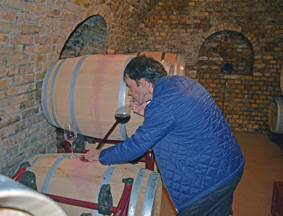 Summary: The Takler Borbirtok is a wonderful wine estate to visit in the Szekszárd wine region. The cellar tour includes a stop in the sanctuary, a must see for wine travel enthusiasts.
Summary: The Takler Borbirtok is a wonderful wine estate to visit in the Szekszárd wine region. The cellar tour includes a stop in the sanctuary, a must see for wine travel enthusiasts.
We arrived at Takler Borbirtok and met András Takler. We soon learned that the Takler family has been growing grapes and making wine since the 1700s in the Szekszárd wine region. The current winery was built in 1987 by Ferenc Takler. Now it is controlled by Ferenc and his two sons Ferenc Jr. (the current winemaker) and András.
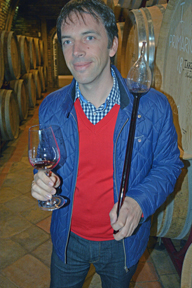 András took us for a cellar tour and tasting. The brick-lined cellar was clean without black cellar mold clinging to the walls and wine bottles. Large wood casks stood side-by-side in some of the corridors. In several areas there were barriques aging red wines. These wine barrels were placed in wine barrel racks resting on wheels. The wheels make it easy when turning the barrel for maintenance. We tasted several wines from barrels. András used a lopo (a wine thief) to extract wine from the barrel.
András took us for a cellar tour and tasting. The brick-lined cellar was clean without black cellar mold clinging to the walls and wine bottles. Large wood casks stood side-by-side in some of the corridors. In several areas there were barriques aging red wines. These wine barrels were placed in wine barrel racks resting on wheels. The wheels make it easy when turning the barrel for maintenance. We tasted several wines from barrels. András used a lopo (a wine thief) to extract wine from the barrel.
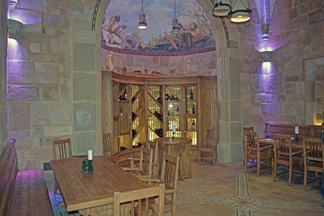 After tasting from barrels, András led us to the sanctuary, an enclosed room in the cellar system that had a higher ceiling compared to the cellars where wine was aging. The sanctuary was a quiet, warmer place than the rest of the cellar system. At the end of the sanctuary an alcove showcased some of Takler’s portfolio of wines, enhanced with low-level lighting.The detailed, painted ceiling in this section of the sanctuary reminds one of the Vatican with its detailed paintings. However the sanctuary ceiling emphasizes the enjoyment of grapes. Tables with benches and chairs lined the sides of this room. Cutouts in the walls had religious artifacts such as a statue of the Virgin Mary and the Angel Michael fighting the dragon. A table was set for a wine tasting. Lighting in the sanctuary was subdued with shades of purple at the corners and soft white lights over head. There were candles on the table. The lighting offered a romantic atmosphere to the room.
After tasting from barrels, András led us to the sanctuary, an enclosed room in the cellar system that had a higher ceiling compared to the cellars where wine was aging. The sanctuary was a quiet, warmer place than the rest of the cellar system. At the end of the sanctuary an alcove showcased some of Takler’s portfolio of wines, enhanced with low-level lighting.The detailed, painted ceiling in this section of the sanctuary reminds one of the Vatican with its detailed paintings. However the sanctuary ceiling emphasizes the enjoyment of grapes. Tables with benches and chairs lined the sides of this room. Cutouts in the walls had religious artifacts such as a statue of the Virgin Mary and the Angel Michael fighting the dragon. A table was set for a wine tasting. Lighting in the sanctuary was subdued with shades of purple at the corners and soft white lights over head. There were candles on the table. The lighting offered a romantic atmosphere to the room.
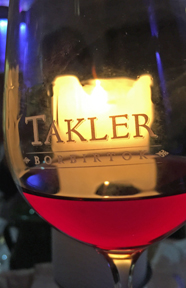 We tasted two wines while in the sanctuary. The 2018 Pinot Noir Rosé was a salmon color with a red hue. The wine had 12.5% alcohol. Red berry fruits were noticed on the aroma. The taste included red raspberry with a trace of strawberry. The finish was crisp with a very fruity long aftertaste. The 2017 Kadarka was a translucent light ruby color with a red hue. This wine also had 12.5% alcohol. The cherry aroma and taste were accompanied by a medium body and mild tannins. This Kadarka was produced only in stainless steel tanks. The finish was fresh and fruity. The wine showcased nicely in the candlelight.
We tasted two wines while in the sanctuary. The 2018 Pinot Noir Rosé was a salmon color with a red hue. The wine had 12.5% alcohol. Red berry fruits were noticed on the aroma. The taste included red raspberry with a trace of strawberry. The finish was crisp with a very fruity long aftertaste. The 2017 Kadarka was a translucent light ruby color with a red hue. This wine also had 12.5% alcohol. The cherry aroma and taste were accompanied by a medium body and mild tannins. This Kadarka was produced only in stainless steel tanks. The finish was fresh and fruity. The wine showcased nicely in the candlelight.
Vineyards
We learned that the Takler estate vineyards comprise of 82 hectares (203 acres). Varietal grapes grown in the vineyards include: Sauvignon Blanc and Chardonnay for the white grapes, and Kékfrankos, Cabernet Franc, Merlot, Kadarka, Cabernet Sauvignon, Pinot Noir and Syrah for the red grapes. In addition to growing their own grapes, the winery also sources grapes from the area wine growers. Production is between 650,000 and 700,000 bottles per year.
Wines
We proceeded to the restaurant where we had a multi-course dinner with András and Gábor Lukács, the general manager for the hotel Takler Kúria. We tasted several wines throughout the three-hour dinner. The 2015 Kékfrankos Reserve was a ruby color with 13.5% alcohol. Black fruits and spices were on the aroma. The taste included black cherries and baking spices. The wine had a medium/full body and medium to bold tannins. The finish was fruity with a background of spices.
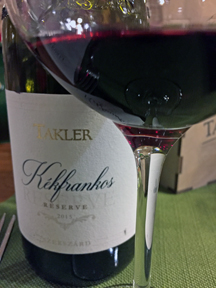 The 2016 Bikavér was a blend of primarily Kékfrankos and Merlot with Cabernet Franc, Cabernet Sauvignon, Kadarka and Syrah. The wine had a translucent ruby color with 14% alcohol. Dark fruits and spices were on the aroma. The velvety mouthfeel was accompanied by black berries, blueberries, black cherries and baking spices. The wine had a full body and medium tannins. The fruity finish had just a touch of spice.
The 2016 Bikavér was a blend of primarily Kékfrankos and Merlot with Cabernet Franc, Cabernet Sauvignon, Kadarka and Syrah. The wine had a translucent ruby color with 14% alcohol. Dark fruits and spices were on the aroma. The velvety mouthfeel was accompanied by black berries, blueberries, black cherries and baking spices. The wine had a full body and medium tannins. The fruity finish had just a touch of spice.
The 2016 Kékfrankos, Szenta-hegyi was a single vineyard wine from the Szenta-hegyi vineyard. With 14% alcohol, the wine offered an opaque dark ruby to black color. The aroma included dark fruits and spices. The taste was reminiscent of black cherries and blackberries. The mouthfeel was velvety and the wine was full bodied with medium to bold tannins. The finish was fruity with only a bit of spice.
The 2016 Cabernet Franc, Szenta-hegyi Vineyard was an opaque ruby color with a sienna hue. The wine had 14.5% alcohol. The aroma had black fruits. Plums and blackberries were on the taste. The full-bodied wine had medium tannins. Fruit and a bit of spice were noticed on the finish.
The 2012 Primarius was a Merlot with 15.5% alcohol. The black colored wine had a ruby hue. The aroma had notes of cherries and cloves. The taste had a velvety mouthfeel and offered notes of cherries, blackberries, cloves, mushrooms and other baking spices. The fruity and spicy finish had a long aftertaste.
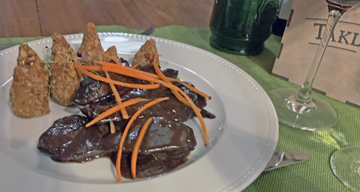 The 2012 Grand was a blend of Cabernet Sauvignon, Kékfrankos, Merlot and Syrah. With 15% alcohol the wine had a black color with a ruby hue. The aroma was reminiscent of a black fruit salad with baking spices. The velvety mouthfeel was accompanied by blackberries, cassis, black cherries and baking spices. The finish was of well-blended fruits and spices.
The 2012 Grand was a blend of Cabernet Sauvignon, Kékfrankos, Merlot and Syrah. With 15% alcohol the wine had a black color with a ruby hue. The aroma was reminiscent of a black fruit salad with baking spices. The velvety mouthfeel was accompanied by blackberries, cassis, black cherries and baking spices. The finish was of well-blended fruits and spices.
With all these red wines, I decided to order wild boar. I enjoy eating an animal that eats vineyard grapes. The three-hour dinner was very relaxing with plenty of conversations.
Wine enthusiasts should visit Takler Borbitok, sample the wines and take the cellar tour. They may also wish to stay at the hotel Takler Kúria for a restful evening. The hotel is situated over the cellars. The hotel is a good base for exploring wineries in the region.
Takler Borbirtok
Decs, Takler Pince Panzió, Decsi Szőlőhegy, 7144, 7144 Hungary
Wine Trail Traveler's Hotel Takler Kúria article
Article written April 2019.
Please support the following Hungarian wineries and wine tour company.
| Wine a'More Travel |



